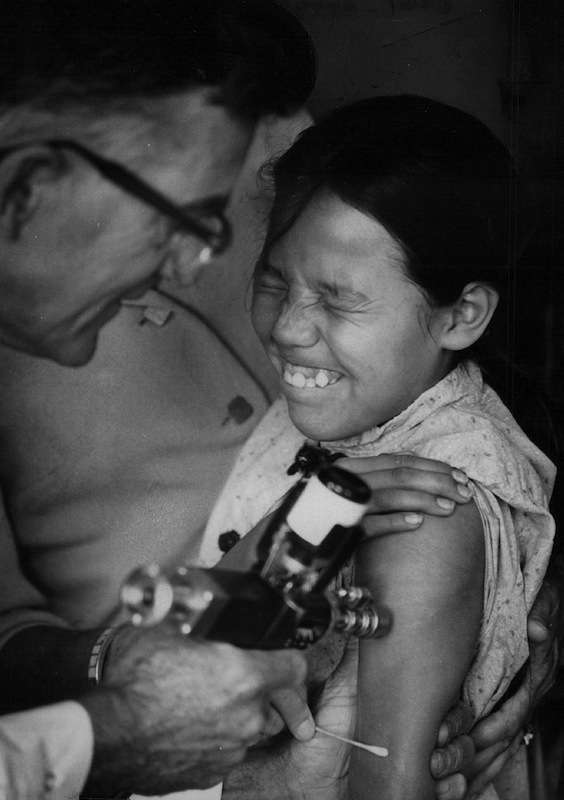
On Monday, the CDC confirmed that there are now more than 100 cases of measles in the United States — which means, an official pointed out, that the number of cases in one month is about as many as usually occur in a whole year. A large majority of doctors believe that the recent outbreak is linked to lack of vaccination among some children, whose parents may believe that the vaccine is dangerous and that measles is not, in spite of White House statements and scientific evidence to the contrary.
This means that, in the parlance of the decades before an effective measles vaccine was developed, 2015 might be called a “measles year.”
Because the disease is so highly contagious, an outbreak often meant that every child in a school system became sickened; their natural immunity would prevent another outbreak from occurring as long as enough of them were still in school; the next outbreak would come, like clockwork, when a critical mass of new students had entered the system. Not that the cycle took very long. TIME reported in 1934 that, for localized epidemics, every second or third year could be a “measles year.”
Then again, the public-health experts of 1934 would probably shrug at 2015’s figures: in that same article, New York City’s Health Commissioner reassured parents that New York’s 413 cases and two deaths in the first 10 weeks of that year — versus nearly 10,000 cases and 44 deaths in the same period of 1933 — did not qualify.
Which makes sense: in 1934 there was no way to vaccinate against measles. The immune system was well enough understood that sick children were often injected with the blood of a parent who had previously had the virus, in order to gain the antibodies, but the isolation of the actual virus itself was still years away. It was 1958 when the virologist John Franklin Enders announced that his team had grown a live, weakened version of the virus, which could be used to inoculate children against the more potent strain that they would otherwise encounter — in other words, a vaccine.
But, then as now, it wasn’t always easy to convince parents to get their children vaccinated.
For one thing, the earliest version of a vaccine, developed by Enders, actually did have a harmful side-effect: measles. Because it was a live-virus vaccine, most people who got it ended up getting a very mild case of the measles; many parents decided it wasn’t worth the shot. By the early ’60s, doctors had developed a compromise that involved giving the live vaccine alongside a serum that, like the early blood cure, contained antibodies that would fight the side-effects. A killed-virus vaccine developed later spared patients the rash and fever but was weak enough that it had to be re-administered several times in order to stick.
Both versions — live plus antibodies, dead plus booster shots — were approved for production in 1963. And, in the next years, progress was made toward a one-shot solution.
However, having the vaccine didn’t mean that parents were convinced to get their children vaccinated. A main issue was that parents — many of whom had themselves suffered with a mild case of the disease — didn’t think measles was bad enough to worry about. In 1967, when the federal government declared a goal of wiping out the disease that year by vaccinating as many as 10 million children, TIME wrote that the disease fighters were “hampered by the public’s unconcern”:
Perhaps because measles always seemed to be an unavoidable part of childhood, it has not loomed as threatening as other diseases, and its characteristic red spots have long been the butt of comic-strip jokes. There were almost 4,000,000 cases a year in pre-vaccine days. In more than 500,000 of the annual cases, according to [Dr. H. Bruce Dull of the National Communicable Disease Center], there were complications such as middle-ear infections; in 4,000 cases, there was encephalitis often with resulting mental retardation, deafness or blindness. In 400 to 500 cases, the disease ended in death.
Still, the public-awareness campaign about the real dangers of measles did not lead 1967 to be its last year in the U.S. In fact, by the late 1970s, the public-health threat had gotten worse in some ways: though more people were vaccinated, for the first time in history the adult population didn’t have near-complete natural immunity from having had the disease.
Measles wasn’t declared eliminated from the U.S. until 2000.
But, though the virus was no longer endemic to the country’s population, the story of controversy over the disease and its prevention was nowhere near done: already that autumn, TIME warned readers that the nascent antivaccine movement might lead measles to make a return.
More Must-Reads from TIME
- Donald Trump Is TIME's 2024 Person of the Year
- Why We Chose Trump as Person of the Year
- Is Intermittent Fasting Good or Bad for You?
- The 100 Must-Read Books of 2024
- The 20 Best Christmas TV Episodes
- Column: If Optimism Feels Ridiculous Now, Try Hope
- The Future of Climate Action Is Trade Policy
- Merle Bombardieri Is Helping People Make the Baby Decision
Write to Lily Rothman at lily.rothman@time.com